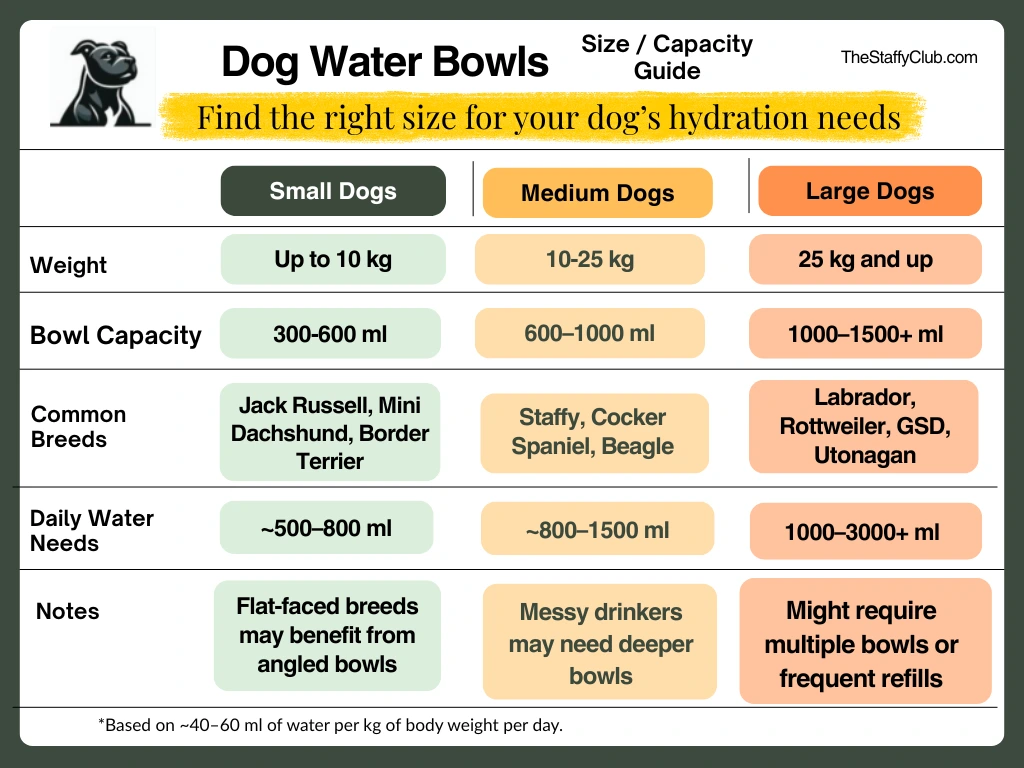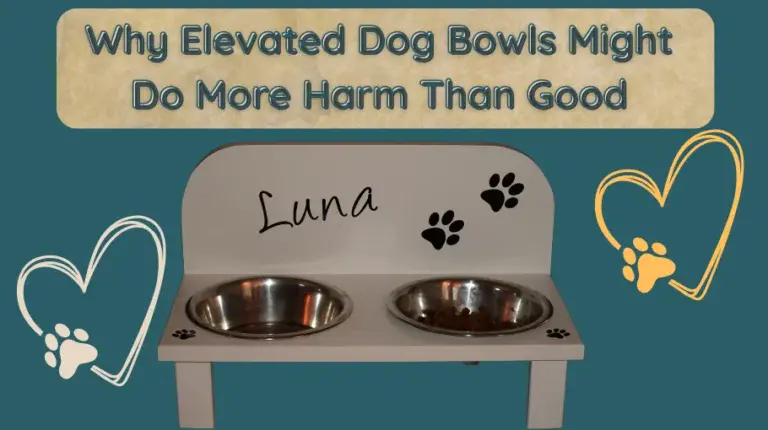Dog Water Bowls for Large Dogs: Your Ultimate Guide

The size of a dog is subjective. We have two Staffies — 24 kg and 26 kg — both lean and fit, according to our vet (we checked for their weight recently when sorting out their worming tablets). To us, they’re medium-sized dogs. But friends often say they look massive. So when people ask about dog water bowls for large dogs, I always wonder — what size are they really talking about?
Know what’s not subjective, and super handy for determining the right size of bowl to use on-the-daily?
This stat: Dogs need 50 to 60 ml of water per kilogram of body weight per day.
By that measurement, we need water bowls to hold 2.4 to 3 litres daily. Doesn’t have to be one bowl. It can be spread across a couple of bowls, like ours – one indoors, the other outdoors. For a large dog though, say, A 70 kg Great Dane, you could need 3.5 to 4.2 litres of water per day… that’s a lot of bowl refills if you’re using something too small.
So, whether you’ve got a big softie like a Lab, a lean powerhouse like a Staffy, or a true gentle giant, the size of their bowl does matter — not just for comfort, but for keeping them properly hydrated.
What You Ought to Know About Dog Water Bowls for Large Dogs
Why It’s Crucial to Get the Dog Bowl Size Right for Large Breeds
Finding the right-sized water bowl for a large dog isn’t just about the litres it can hold — it’s about comfort, hygiene, and how easy it is to maintain a steady hydration routine.
Here’s what can go wrong at both ends of the sizing scale:
| Too Small | Too Large |
| Needs refilling too often | Water may sit too long and go stale |
| Can frustrate a thirsty dog | Can be harder to clean thoroughly |
| More likely to spill or be tipped over | May not fit easily in feeding areas |
| Less suited for dogs that gulp water quickly | Might cause dogs to drink less if water tastes warm or metallic (e.g. in steel bowls during summer) |
| Doesn’t match daily water needs | Bulkier bowls may be harder to move or travel with |
Even if you’re just eyeballing your dog’s needs, getting closer to the right capacity can make a huge difference in daily routine and water intake.
Why 60ml per KG Might Not Be Enough — Especially in Summer
Even I’m guilty of parroting the stat that dogs need 50–60ml of water per kilogram of body weight per day. While it’s not wrong, it’s definitely not the whole story.
What it really is: a bare-minimum estimate to keep a healthy dog ticking over in normal conditions.
For a 24kg Staffy like ours, the general guide is about 1.4 litres a day. But that number shoots up fast if your dog:
- Spends time in the sun
- Eats mainly dry kibble
- Zooms around the park like they’re still a puppy
- Pants a lot (especially snub-nosed or heavyset breeds)
… And large breeds? They can burn through water even faster… not just because they weigh more, but because bigger bodies lose more heat and moisture. For example, a Utonagan, with its thick double coat, can need 3 litres or more on a warm day, especially after exercise.
In other words, 60ml per kg is a starting point, not a target.
That’s why choosing the right bowl size matters. A bowl that’s too small might leave your dog without sufficient liquids by mid-afternoon, while one that’s big enough keeps hydration steady (and means fewer refills for you).
Too Small, Too Big, or Just Right: Finding the Fit
Let’s be honest… most of us don’t top up the water bowl every few hours. And if you’re out for work, or away shopping for hours on end, your dog might be left for 4, 6, or even 8 hours before you’re home to refill it.
So here’s the thing:
It’s not just about how much your dog drinks in a day — it’s how much they’ll need while you’re not around.
If your dog drinks around 1.5 litres a day and you’re gone for 8 hours, their bowl needs to comfortably hold at least a litre (more if it’s hot or they’ve had a long walk before you leave).
And it’s not just about avoiding dehydration either. A bowl that runs dry can lead to:
- Excessive panting or heat stress, especially in warmer months
- Frantic drinking when you return, which can lead to vomiting or bloating
- Guarding behaviour around scarce water — surprisingly common in multi-dog households
On the flip side, too big of a bowl can be a pain to clean, more prone to collecting debris or dust, and might even discourage some dogs from drinking (especially smaller ones). I thought going for a large-sized dog bowl would mean less cleaning — turns out, it just led to me scrubbing the green algae from the dog’s water bowl! Larger is only better if it’s being drunk or refilled regularly, not left to go stale.
So, rather than guessing based on weight alone, think about:
- How long your dog is unsupervised
- Whether they get wet food or only dry kibble
- Their activity levels, age, and breed quirks
- In a multi-dog household, a single dog bowl that’s designed for a large-sized dog can actually be the safer choice for two smaller dogs, helping avoid competition and keeping them both hydrated when you’re not around.
A well-matched bowl size keeps water available when they need it most, without constant topping up from you.
Water Bowl Sizes and Capacity Guide (With Chart)
Dog bowl sizes are best measured by capacity, not diameter or depth. That’s why when you’re browsing listings online, you’ll usually see the volume — in millilitres (ml) or ounces — right in the product title. It’s a more practical measure of how well a bowl will suit your dog’s needs, as shown in the chart below…

Why Bowl Shape and Depth Matter (Especially for Large Dogs)
When it comes to large dogs, bowl shape isn’t just about looks — it can make a big difference in how easily (and cleanly) your dog drinks. Bigger breeds often have stronger gulps, heavier jowls, and larger tongues. That combo? It’s a recipe for puddles if the bowl isn’t up to the job.
Take our two Staffies, for example — classic messy drinkers. We’ve learned it’s far better to use a deep or large-capacity bowl filled halfway than a small, shallow one filled to the brim. It keeps the floor drier, and we refill less often (because we use multiple bowls).
Here are a few shape considerations worth knowing if you’ve got a large or extra-large breed at home:
- Deep or High-Walled Bowls
Best for: Messy drinkers and jowl-heavy breeds like Boxers, Bullmastiffs, or Staffies
Why: Helps contain splashes during enthusiastic drinking sessions
- Wide-Bottomed or Weighted Bowls
Best for: Strong, head-heavy dogs
Why: More stable on the floor — less likely to tip or slide across the kitchen mid-drink
- Elevated Bowls
Best for: Older dogs, or breeds prone to joint or spine issues (think Labs, Shepherds, Rottweilers)
Why: Makes drinking easier by reducing neck strain — and with adjustable options, you can tweak the height as your dog grows or ages.
Are Elevated Dog Bowls Better for Large Breeds?
It’s easy to see why elevated bowls are popular with large dog owners — they look like the practical choice. Less bending, easier access, and often more stable than ground-level bowls. But they’re not without risks, especially if your dog is prone to gastric dilatation-volvulus (GDV), also known as bloat.
The research is mixed, but some studies have linked elevated feeders to an increased risk of bloat in large and giant breeds — particularly when dogs gulp down food or water too quickly. That said, for older dogs with joint stiffness or spinal issues, elevation can offer better comfort.
For large breeds susceptible to bloat, it’s a good idea to get the lowdown on how to prevent bloat in dogs before it becomes an issue. While elevated bowls can be helpful, it really comes down to getting the height right.
The right height is chest level — not head height. Your dog’s neck should stay fairly straight, not stretched up or bent down, when drinking.
If you’re going elevated, go adjustable.
That way, you can fine-tune the height as needed and avoid placing the bowl too high — which is where most of the risk creeps in.
And remember: bowl height isn’t just about comfort. It affects posture, gulping speed, and ultimately, digestion. So it’s worth getting right, especially for deep-chested, large breeds.
A mate of mine recently switched to an adjustable elevated bowl and reckons it’s made a real difference to his dog’s eating and drinking habits. Nothing dramatic — just steadier, more relaxed mealtimes. And with large breeds, small changes like that can make a big difference over time.
Final Thoughts: Size Is Just the Start
Getting the right size dog bowl matters — especially for large breeds. A bowl that’s too small can leave your dog parched by midday. Too big, and you risk spills, mess, and even encouraging your dog to gulp water too fast. But as you’ve seen, size is only part of the story.
Other factors count, too:
- Water availability (especially if you’re out for hours)
- Bowl material (plastic might be cheap, but it’s not always the best for hygiene)
- Elevation (great for some dogs, risky for others — especially if the height isn’t right)
- Daily habits (like how often you clean the bowl, or whether you top it up often enough)
It’s not just about keeping your dog hydrated — it’s about making hydration effortless, consistent, and safe.
If you’re looking to upgrade or simply want peace of mind that you’ve got the right setup, our guide to the best water bowls for dogs rounds up tested, well-reviewed options that work for real-life dog owners, including those with large or messy drinkers like our pair of thirsty Staffies.
And remember: water is one of the easiest ways to support your dog’s health. The right bowl just makes that easier.
Frequently Asked Questions
Do large dogs need elevated water bowls?
Elevated water bowls can help reduce neck and back strain for large dogs, especially those with arthritis or mobility issues. However, some studies suggest they may increase bloat risk in certain breeds, so adjustable bowls and vet advice are important.
How big should a dog bowl be for a large dog?
Large dog water bowls should hold enough to meet their daily water needs—typically around 2 to 3 litres (2000–3000 ml)—depending on the dog’s weight, activity, and how long they’re left without refills.
How many bowls of water should a large dog drink a day?
Dogs generally need about 50–60 ml of water per kilogram of body weight daily, but this varies with activity, weather, and diet. For a 40kg dog, that’s roughly 2 to 2.4 liters per day, which can be split across several bowls or refills.
Do dogs drink more water with dry food?
Yes, dogs eating dry kibble tend to drink more water compared to those on wet or raw diets because dry food contains less moisture. Providing a large enough water bowl ensures they stay properly hydrated.





